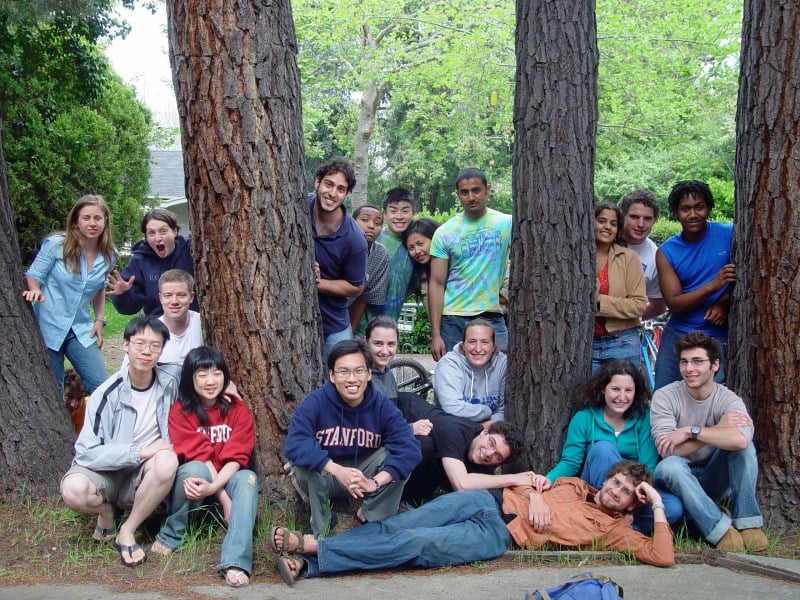Students choose to live in Hammarskjöld — Stanford’s international-themed student residence — for a variety of reasons. Lily Nilipour ’22 wanted to live in a place that is intentional about community. Similarly, Cat Clark ’20 M.S. ’22 was attracted to the small but tight-knit community of the house. Ravichandra Tadigadapa ’22 M.S.’23 liked the international theme, while Ishira Fernando ’21 M.S.’22 ended up in Hammarskjöld by chance. Sarah Nader ’15 M.S. ’16 and Robert Carrera ’15 M.S. ’17 wanted to live among the house’s upperclassmen, whom they looked up to. And Naree Chan ’06 loved the cleanliness of the house.
But all of them left the residence with the same feeling: so much love for Hammarskjöld.
Cooperative houses (co-ops) like Hammarskjöld are different from traditional student residence halls. They are student-managed residences where house members share responsibilities for house activities and cooperate in house governance.
From the purchasing of food and supplies to coordination of jobs and budgeting of finances, Hammarskjöld residents, who are both international and non-international students, join hands in the operation of the house, which often makes residents feel more at home in Hammarskjöld than traditional student residences.
Hammarskjöld opened in the 1972-73 academic year, meaning that the next academic year will mark the house’s 50th anniversary. Several international students, with the help of the Bechtel International Center, set up the international co-op. Named after former United Nations Secretary-General Dag Hammarskjöld, the house was intended as a place to nurture differences.
For both Nilipour, who is from San Diego, and Clark, who is from Delaware, the house was a space where they encountered different perspectives and cuisines.
At Hammarskjöld, Nilipour got to have discussions that broadened her perspective beyond the western, American way of thinking. “It is great to have a lot of people in the house who discenter my perspective,” she said.
Clark said that the dining room was her favorite part of the house. It was where she made memories eating food from different cultures that were made by other residents.
Fernando from Sri Lanka also recounts learning to have meaningful conversations from the Hammarskjöld people. He believes that the house is “markedly different to most other residential spaces on campus” because starting a conversation in Hammarskjöld with anyone in the house on a busy weekday is incredibly easy.
“I’ve talked to people here about the climate, biodiversity loss, coming out, the children of venture capitalists, lost zip cars and much, much more,” he said. “These conversations have genuinely been some of the best in my life.”
Hammarskjöld’s commitment to the international theme creates a space to have conversations about issues relevant to Stanford’s international community with both kinship and non-judgment, according to Fernando. “The beauty of the house is that due to the constant conversations that are had in the house about being an international house, even the non-internationals in the house are cognizant and understanding of the challenges of international students.” For Fernando, living in Hammarskjöld feels like living with a family.
And families do really start in Hammarskjöld. Just this month, former residents Carrera and Nader got married.
The couple hosted their Rehearsal Dinner at the backyard of Hammarskjöld with a whole table just for Hammarskjöld residents. They even served a special cocktail named “Hammbrosia” for the guests. “It was amazing to be back in the house,” said Nader. She said she was happy to “celebrate a special moment at a special place.”
As students in Hammarskjöld, Carrera and Nader remember doing chores and cooking together. Now, as husband and wife, they appreciate everything they learned during their time as Hammarskjöld residents. At Hammarskjöld, they learned how to operate a house — and now the house is their own shared home.
Chan is also married to a fellow Hammarskjöld resident. She remembers meeting her husband for the first time during a Thanksgiving celebration in the house.

Besides holiday gatherings like Thanksgiving, Hammarskjöld had many other traditions, according to Chan. From the Hamm Olympics and Halloween to the Talent Show, the house is in a “fun and festive” mood throughout the year, she said.
Today, Hammarskjöld remains a space in which people come together and view themselves as citizens of one world, according to Tadigadapa, who is one of the house’s resident assistants.
So far, the house has celebrated Mid-Autumn Festival, Lunar New Year and Mardi Gras, among other holidays. On top of celebrations, all of the residents did an individual spotlight that revealed something from their background, culture and interests.
Tadigadapa said that Hammarskjöld could work to make the house and its community more accessible to everybody on campus. As a “proud Hammarskjöld,” he said that he is excited about what the future holds for the house.
